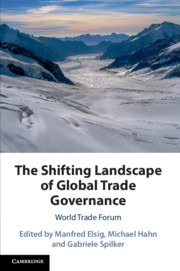Book contents
- The Shifting Landscape of Global Trade Governance
- The Shifting Landscape of Global Trade Governance
- Copyright page
- Contents
- Figures
- Tables
- Contributors
- Preface
- Abbreviations
- 1 Introduction
- Part I New and Old Challenges
- Part II Trade Policy and Trade-Related Concerns
- Part III Development Angles
- Part IV Diffusion across Economic Treaties
- 14 Heading for Divorce?
- 15 The Regime Complex for Investment Governance
- 16 Asian Trade Agreements in Services
- Index
- References
15 - The Regime Complex for Investment Governance
Overlapping Provisions in PTAs and BITs
from Part IV - Diffusion across Economic Treaties
Published online by Cambridge University Press: 05 August 2019
- The Shifting Landscape of Global Trade Governance
- The Shifting Landscape of Global Trade Governance
- Copyright page
- Contents
- Figures
- Tables
- Contributors
- Preface
- Abbreviations
- 1 Introduction
- Part I New and Old Challenges
- Part II Trade Policy and Trade-Related Concerns
- Part III Development Angles
- Part IV Diffusion across Economic Treaties
- 14 Heading for Divorce?
- 15 The Regime Complex for Investment Governance
- 16 Asian Trade Agreements in Services
- Index
- References
Summary
This chapter investigates the overlapping nature of investment governance, in which BITs and PTAs encode common commitments toward the protection and liberalization of investment. It advances the scholarship on regime complexity, in which non-hierarchical and overlapping institutions regulate investment. The study examines common institutional design across PTAs and BITS, while recognizing that the broader investment regime complex includes legal precedents set through dispute settlement at the WTO and ICSID. Utilizing an original data set of investment provisions in PTAs and for BITS data provided by UNCTAD’s International Investment Agreements (IIA) project, the analysis examines how these two international agreements have co-evolved in terms of institutional design in guiding principles, scope, and enforcement. The hypothesis is that these two types of agreements are largely complementary, where PTAs emphasize liberalization of investment in tandem with other trade-related provisions, and BITs emphasize the protection of investments and investor rights. The results of principal component analysis of provisions in PTAs and BITs support the hypothesis of complementarity. Additional analyses also show that investment provisions in PTAs draw heavily from those of BITs, but BITs draw less from PTAs.
Keywords
- Type
- Chapter
- Information
- The Shifting Landscape of Global Trade GovernanceWorld Trade Forum, pp. 359 - 387Publisher: Cambridge University PressPrint publication year: 2019
References
- 2
- Cited by

